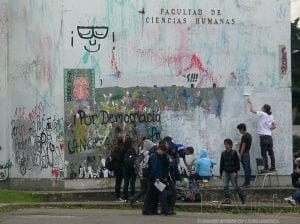Combating Inequity through Higher Education
Private-Public Alliances

Students are sometimes paid to cover up graffiti on university walls. It is more difficult to cover up the pressing need for quality higher education in the region. Photo by Harlan Downs-Tepper.
Public and private sectors must form alliances in order to offer quality education for the majority of the population. Throughout the Americas, students have been protesting, particularly around the issue of burdensome student loans. In Canada, the United States, Colombia and Chile, students have demanded a substantial improvement of education and its financing and, in Chile, they have also demanded that higher education be free. Unfortunately, given the economic situation of Latin American countries, free education is unviable; among other things, it would benefit high-income students who can afford to cover their own educational costs. Obviously, what is needed are innovative solutions that have frequently been used in other regions of the world to offer students loans, payable at the end of their studies with reasonable conditions.
Thus, as in other aspects of higher education, there is a need for a strong public-private-academic alliance. Funding is required for scholarships and loans with innovative solutions, which have already been applied—albeit in a limited fashion—in some Latin American countries. The most convenient scheme would let a student cover his or her educational costs (depending on his or her economic situation) by one of three means or a combination of these: a scholarship; a subsidized loan that is forgivable on the basis of the student’s academic performance and the successful completion of his or her studies in the time limits set by the program; and a long-term subsidized loan that can be paid off once the student ends his or her studies and begins working. The last one would enable the student to return part of the cost of his or her training to society and, in turn, help other students to finance their studies. The public sector should increase current resources and the private sector could invest in training high-level human capital. The loan total and the conditions of the forgivable loan must be carefully designed so that the repayments can be made according to the expected future earnings of the young professionals.
Quality education, as offered by many public and private universities all over the world, requires ever increasing financial resources. Public institutions in Colombia are highly dependent on government funding; private institutions have to generate all of their revenue and depend largely on undergraduate tuition fees. Thus, the challenge for aspiring research universities, in terms of financial resources, is immense.
Public universities charge very small fees and in some cases, subsidize, unnecessarily, students from middle-and high-income backgrounds. This policy should be reviewed to see if additional revenue could be obtained. Government financial resources are mainly distributed to universities on the basis of their student population, regardless of university quality and administrative efficiency. Measurements such as the success coefficient in the completion of undergraduate studies, study duration and administrative efficiency goals should become an essential part of the equation in the determination of how financial resources are distributed.
Private universities should continue to be responsible for their revenue generation. To promote quality, government funds for scholarships and subsidized loans should prioritize students from low-income economic backgrounds who obtain the top results in the secondary school evaluation tests.
The end result is that funding is of the utmost importance for higher education. Hence the need for public-private sector alliances to generate resources to improve higher education. Some examples illustrate their importance. The most relevant are found in Brazil and are the long term alliances that resulted in Embraer, aeronautical engineering, and Embrapa, agricultural development. Colombian Colfuturo, begun in 1992 as a public-private alliance, has evolved into a private endeavor and has provided funding for some 5,700 students to undertake graduate training in top world universities. On a smaller scale, but very innovative, was the Harvard-Universidad de los Andes endowment fund, stared some 30 years ago, which has contributed to the strengthening of Universidad de los Andes faculty. The need for qualified personnel in Earth Sciences generated a very effective public-private alliance; mining and oil industries are contributing substantial resources for chairs and scholarships for the new Universidad de los Andes Geoscience program. Colombian Colciencias has promoted academic research in collaboration with industry and some important results have already been obtained; continuity and additional resources are required to ensure the success of the project.
Colombia is not noted for its philanthropic activity. However, in the last few years important resources have been contributed by the private sector to ¨Quiero Estudiar,¨a program started at Universidad de los Andes in 2006 that has allowed some 800 very well qualified students, of limited financial resources, to attend the university.
Sources of funding are essential in Latin America, where Gini coefficients—a standard measure of inequality—are higher than 0.5 in all countries in the region. Thus, inequity is one of the most important problems affecting Latin America, Colombia in particular. Governments have tried to reduce this inequity, but innovative approaches are needed.
The links between Latin American universities and the production sector are as yet weak, and their strengthening is essential to technological development. The promotion of entrepreneurship in undergraduate and postgraduate programs also merits consideration.
Today’s Situation
Education in Latin America is extremely heterogeneous and enrollment rates fluctuate: in primary school, between 40 percent and 100 percent; in secondary school, between 70 percent and 95 percent; and in post-secondary education, between 18 percent and 70 percent. To add to the problem of low enrollment, quality is not very uniform, and often extremely deficient. For the most part, Latin American countries do not participate in Program for International Student Assessment (PISA) testing, assessments that focus on 15-year-olds’ capabilities in reading and mathematics literacy. When Latin American students do take the test, their performance compares unfavorably to their counterparts in countries in other regions of the world. Given that the quality of a person’s basic education sets the standards for his or her future, those who receive deficient education in the initial phases experience great difficulty in correcting their shortcomings later on, and may incur considerable costs. In higher education, there is a noticeable lack of technicians and technologists and, in some cases, an excess of professionals who lack adequate training and therefore have difficulties in finding adequate employment. Quality education, although costly, is an investment for the future. It provides added value in all its phases; unfortunately, government resources are limited and students have to cover at least part of the costs for their studies.
Quality higher education is an essential ingredient for the development of a country and it is easy to find a correlation between education and development. The competitiveness index for Latin American countries is low; thus, the importance of improving education in Latin America is enormous, with both additional enrollment and, more importantly, a substantial improvement in terms of quality.
Quality, as we well know, is necessarily linked to the quality of the teachers, who all too often have deficient academic training and lack pedagogical skills.
Universities depend too much on part-time professors, who normally teach in a number of institutions at the same time with irregular results. This combination of factors has led to the proliferation of the so-called ¨garage universities,¨ which have a very basic infrastructure and limited academic resources and which, more often than not, are profit-making organizations that offer very low-quality education. These institutions invest substantial amounts of money in marketing to attract students; their graduates, however, end up inadequately paid and in jobs for which a university degree is not necessary. Low-income students, who have been through a deficient basic and secondary education, are the ones who usually attend these institutions, further hindering their chances of climbing the social ladder. It is a perverse system that ought to be controlled.
The development of solid technical and technological institutions that offer quality training pertinent to the requirements of the country is a the desirable alternative. What is the best option for a country, a frustrated university graduate who cannot find the right job, or a highly trained technician or technologist who is useful to society? A barrier that needs to be gradually broken down is Latin American society’s lack of social recognition for technicians and technologists, rendering these professions less than attractive. Every country needs a reasonable ratio—currently only to be found in developed countries—of technicians and technologists, and university graduates.
Unlike in developed countries, in Latin America it is common for an institution to “migrate” to another level without being prepared for it. Thus, a competent technical institution can turn into a technological institution and later into an undergraduate university, and on to a postgraduate university, and subsequently a research university. This process usually leads to a level of incompetence known as the Peter Principle.
In 2007, the Interuniversity Development Center (CINDA) conducted a study on higher education in Ibero-America. In 2011, it prepared an updated study that allowed monitoring through a four-year period. The study indicated that some progress had been made, but that a daunting task lies ahead. These studies show that the total expenditure in education in 2008 varied between 0.2 percent and 1.7 percent of the GDP with a significant input from the private sector in some countries such as Colombia. In developed countries such as Canada and Korea, this expenditure is just over 2.5 percent of the Gross Domestic Product (GDP), which means that Latin America needs to increase its education budget and improve its disbursement.
Private higher education enrollment in Latin American countries varies considerably. In 2010 it fluctuated between 27 percent in Argentina and 80 percent in Chile. In addition, the success percentage for completing undergraduate studies is very low, varying between 20 percent and 60 percent from country to country; in the case of technicians and technologists and in the so-called “garage universities,” it is even lower. An increase in the success coefficient, with more graduates attending the same facilities, would lead to a very efficient use of resources.
Some advances have been made over the last few years is in ensuring the quality of Latin American higher education institutions. Accreditation entities have been created to undertake evaluations of both institutions and specific undergraduate and postgraduate programs. Coverage, in terms of accreditation, is still low and currently in Colombia—where this process began in 1998—it is of 6.7 percent of university institutions and 9.3 percent of accredited programs. Strengthening and expanding accreditation is of fundamental importance to force the institutions to really improve their programs and duly inform the student community of the developments in the system.
Thoughts for the Future
University rankings have become more relevant, and even though their results should be carefully analyzed, they provide an idea of the relative position of a university in the global context. The United Kingdom’s QS ranking includes only 2 Latin American universities among the first 200 in the world and 16 among the first 500.
Evidently, Latin American countries must increase their efforts to improve enrollment levels in secondary and higher education. They urgently need to substantially improve the quality of education, which is currently heterogeneous and varies greatly within urban areas and, in particular, between urban and rural areas.
The training of qualified teachers is fundamental for a quality education in Latin America. We must try to attract young people with a high level of academic training to the profession by offering them attractive working conditions, as has been done in Finland and Singapore. Some interesting initiatives have been created in this direction in Argentina, Chile, Colombia and Peru with programs that follow the Teach for America guidelines. If these initiatives are continued and consolidated, they could bring about extremely positive effects in the future.
Higher education institutions in Latin America must focus on activities that will lead to quality technical, technological and university institutions that offer programs pertinent to the country. The Carnegie Classification of institutions of higher education, which adequately recognizes the diversity of institutions, constitutes a good guide. As well as technical and technological institutions, countries should also have community colleges, undergraduate universities, universities for postgraduate studies, and some research universities that are essential to a country’s progress.
Additionally, given the region’s characteristics, it would be important to motivate students to enroll in agricultural programs since few graduate in these areas and the opportunities afforded by the large undeveloped areas are enormous. The heterogeneity of education in different countries needs to be controlled and monitored by governments, institutions and their personnel. Strict standards must be imposed to keep students, generally low-income ones, from feeling frustrated because they are not able to obtain the education they want.
Programs need to be implemented that will help reduce attrition rates in higher education, in order to increase coverage without additional costs. The articulation of secondary and higher education, personal and academic counseling and financial support can be combined to achieve this purpose.
Undergraduate programs need to be redesigned in order to adapt them to the dynamic development of knowledge and the excellent prospect of making education a life-long process. Programs similar to those at the best U S. universities, with strong humanistic training and high levels of interdisciplinary, electivity and flexibility are the most adequate for training professionals who can be adaptable to a dynamic globalized environment.
In the best higher education institutions, an important generational phenomenon is taking place whereby young well-qualified, pedagogically trained academic professionals, will be the professors of the upcoming generations. Working conditions are becoming more and more favorable and a number of institutions have a critical mass of qualified academics that serves to attract very well qualified professionals.
Universities must continue to strengthen the processes of internationalization through student and teacher exchange programs, as part of agreements with prestigious international universities. The programs offered by universities with high academic recognition must be welcomed in Latin American countries, but not those offered by universities with a low level of recognition that do not have sufficient demand in their home countries and thus try to take advantage of their installed capacity by recruiting foreign students.
The challenges for universities that aspire to become research universities are daunting, given the resources required for professors´ training, for providing adequate research infrastructure, and for the acquisition and up-dating of information and communication technologies along with library resources. Yet it is the only route to adequately train academics to develop quality research projects and, in some fields, generate new technologies. Low levels of investment in research in all countries constitute an important limitation.
Instead of the improvisation and changes of policy frequently observed in some countries, state policy designed for the long term is of the utmost importance to obtain quality education.
In sum, higher education institutions, especially universities, face a transcendental challenge over the next few years: that of efficiently contributing to the leap which Latin American countries must take in order to join the developed world. The alliance between the public-private-academic sectors can contribute greatly to achieving these results.
Fall 2012, Volume XII, Number 1
Carlos Angulo-Galvis was president of the Universidad de los Andes in Bogotá, Colombia, from 1997-2011. A civil engineer, he studied at the Universidad de los Andes and the University of Pittsburgh.
Related Articles
University Lessons: Editor’s Letter
I learned about universities on the barricades. Well, not exactly. I was a philosophy student at Barnard—the women’s college at Columbia University—when the uprising began in 1968. Students, including my boyfriend and several classmates, took over buildings to protest…
The Last Word
More than twice as many Latin Americans are attending institutions of higher education than two decades ago, and the number will continue to increase as more students graduate from secondary schools. ReVista’s timely focus on higher education is thought-provoking…
Making a Difference: A Problem With the UN Millennium Goals
Every Saturday for two years, Estevana Sánchez walked through the jungle for miles, in the dark, crossing a river in the rainy season, to finish high school. Her five teenage children did the same. At the end of the trail, they took a long bus ride to the town of San Juan del Sur…




